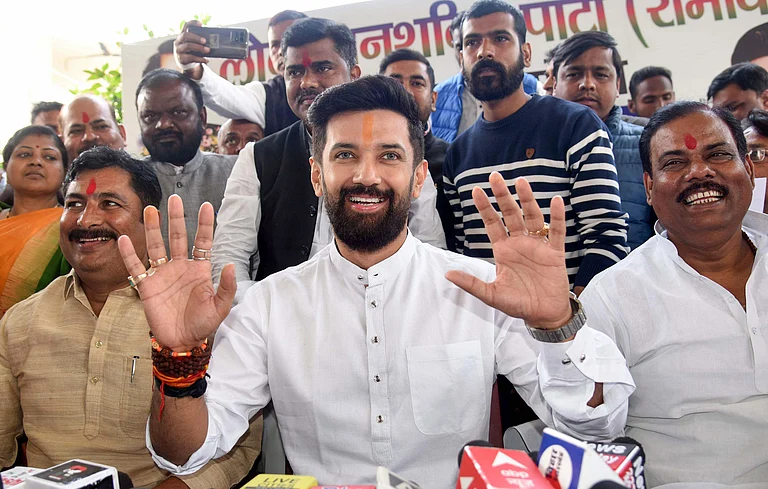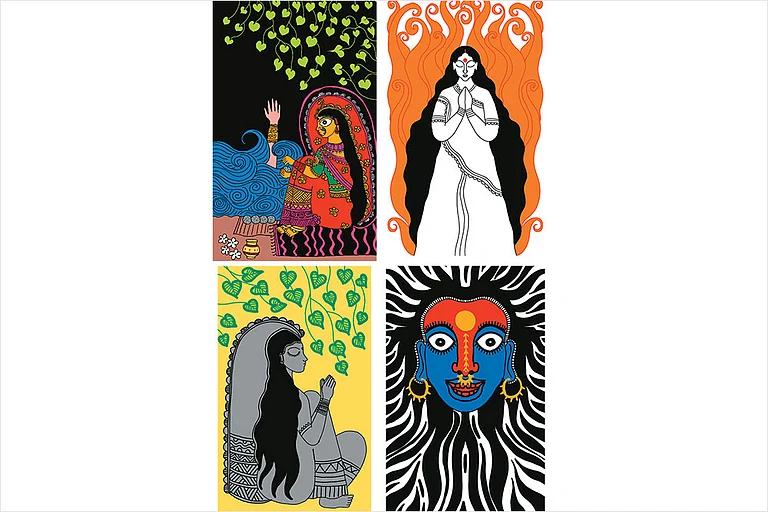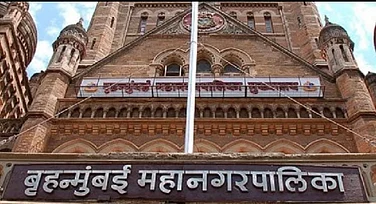In Bihar, the common salutation is "Siya var Ram" (Sita’s husband Ram), emphasising how Ram’s identity is intertwined with Sita’s. Hindu mythology is incomplete without Sita, who embodies strength, resilience, valour, love, sacrifice, and grandeur. Across her many manifestations, one constant is her identity as the "daughter of the soil" (dharti ki beti), representing Bihar.
For folk artists from the state, Sita holds varied meanings. As these nationally and internationally acclaimed artists, including some Padma Shri awardees from scheduled and backward castes, gather to depict different phases of Sita's life at the Bihar Museum for the Bihar Museum Foundation Day on August 7, we explore what Sita signifies to them. In a contemporary context where Ram often overshadows discussions, where does Sita stand?
Kaveri Mishra
“Sita ke sakala dekhi jakhathi jana kari
Si Sita bheli byahana jo gayo hariyargo
Bara bhamanani payela dhanusha ke dela utha gaye ho
Desha hi dhesh ke Ram ni loka ela dhanusha ke chubi chubi jaye yo
Desa baithela Sita dharma pukarti jodhe ji ta to bhaga manayo”
(Song of Mithalanchal)
When King Janak sees his daughter Sita's face
He realizes ruefully that his daughter is of marriageable age
The big palace is being cleaned with green cow dung
And the bow has been kept against the wall
Beautiful people from across kingdoms come, but can only touch the bow
Sita sits and prays, wondering who is fated to be her partner
Mighty Sita
Baua Devi, a Padma Shri award winner, sings this ‘swayamwar’ song while illustrating scenes from Sita’s life on her canvas. She explains, “The floor was cleaned with green cow dung, and the 'Shiva' bow was placed on it. When Sita effortlessly lifted the heavy bow, Raja Janak was astonished, as he could not believe that she could do so. He decided that she would marry the man who could break the bow. This episode highlights Sita’s valor. Despite numerous suitors, Sita prayed only for Ram and his courage. The song is traditionally sung in our village in Madhubani during weddings.”
For Mithila artists like Baua Devi, Sita is always Janknandani, the powerful daughter who, once found by Raja Janak emerging from the earth, brought prosperity and became a cherished daughter in their lives.
Politics of Caste
Various art forms from Bihar, including Mithila (Madhubani) painting, Manjusha painting, Tikuli art, Applique work, and Sujni, have been preserved mainly by individuals from scheduled, backward, and other marginalised castes. Historically, Dalits faced severe restrictions, including exclusion from depicting Ramayana and using colours. Despite enduring struggle, injustice, and discrimination, their dedication has kept traditional art forms alive, earning recognition and accolades for the state.
Mithila painting is known for its distinctive styles and patterns, with artists experimenting with new techniques while retaining traditional elements. Godna painting, an ancient tradition, has also expanded Mithila art, with Shivan Paswan from Laheriya Ganj, Madhubani, being a master of this style. Padma Shri Award winner Shivan Paswan reflects, “Despite social discrimination and poverty, I challenged traditional Mithila themes dominated by higher-caste artists by choosing Raja Salhesh, a deity of our marginalised Dusadh community, as a subject. This bold move was a departure from the Ramayana and Mahabharata themes. We started using cow dung due to a lack of resources and faced caste-based restrictions on the patterns and colours we could use. We only painted Ramayana when commissioned.” Shivan Paswan’s depiction of Sita’s abduction by Ravan highlights her intelligence as she cleverly used her rings and jewelry to mark her location for Ram and Lakshman.
The first Dalit female artist to receive the Padma Shri in Mithila painting, Sita Devi, alongside her husband Shivan Paswan, has popularised the Godna style. For her, Ram's identity is inseparable from Sita’s. She asserts, “We always say Siya Ram. Without Sita, Ram would not be known. Sita is the daughter of Bihar, whereas Ram was the son-in-law. We feel a closer connection to Sita. Sita and Ramayan belong to everyone. I have as much right to depict Sita as anyone from a higher caste.”
Manjusha painting, characterised by its use of just three colours—pink (sacrifice), yellow (peace), and green (prosperity)—originates from the Kumbhakar (potter) and Malakar castes. Manoj Kumar Pandit, a Manjusha artist from Bhagalpur, says, “This workshop offers a unique chance for folk artists to showcase various phases of Sita’s life. Through Manjusha art, I am portraying Sita as a powerful woman making her own decisions. My depiction includes Sita performing Pind Daan for King Dasratha, witnessed by natural elements. Despite challenges and Ram’s eventual disbelief, the banyan tree testified to Sita’s ritual, revealing her power and determination.”
First of Its Kind
Anjani Kumar Singh, Director of Bihar Museum, sees this workshop as a groundbreaking initiative to present Sita’s multifaceted persona. He explains, “There are numerous stories and songs about Sita, but they have never been presented collectively. Sita, connected to nature, was born from and returned to the earth. For Bihar Museum Foundation Day on August 7, we chose Sita as our theme, inviting 30 renowned folk artists engaged in Mithila painting, Manjusha painting, Tikuli work, Sujani work, and Applique work. Mithila artists traditionally used only black and white, focusing on nature. This exhibition allows them to use color and depict Sita in diverse ways. Our approach treats Sita as a human entity.”
Ashok Kumar Sinha, Additional Director of Bihar Museum, believes Sita serves as a symbol in global discussions on women’s empowerment and struggles. He says, “To honor the daughter of Bihar, we are organizing events focused on Sita’s life. In a world where women often face passive roles and societal constraints, Sita's life and struggles offer inspiration. This series of events aims to present Sita not just as a goddess but as a woman and daughter of Bihar. Thirty renowned folk artists specializing in various forms are participating from July 31 to August 7, culminating in an exhibition on Foundation Day.”
A Stitch in Time
The Sujni quilting technique, originating from the Persian word ‘sozni’ (meaning needle), involves storytelling through colorful chain stitch embroidery. Nirmala Devi, a 73-year-old award-winning artist from Bhusra village, Muzaffarpur, runs an NGO and crafts Sita’s exile through her work. She laments her daughter’s disinterest in continuing the tradition. “I learned this technique from my mother, used for making godri (baby mattresses) and phaliya (baby blankets). Sita, always connected to nature, is depicted in exile with Laxman carrying her on the chariot. The story reflects her suffering and enduring connection with nature.”
Applique Work, another traditional technique, features diverse designs inspired by nature, everyday life, and folklore. Ruma Verma, a state award winner, uses Applique Work to depict Sita’s daily life in exile. She states, “Sita, a nature lover, stayed close to her surroundings even in exile. My work uses materials from Bihar and integrates Bhojpur block prints. Sita’s environmental affinity is reflected in my art.”
Sita Shines
Tikuli painting, originating from 17th-century bindi designs, was revived by Upendra Maharathi in 1950 and continued by Padma Shri Ashok Kumar Biswas. He explains, “Tikuli art involves board and color as raw materials, providing livelihood to numerous artisans. I depict Sita entering Ayodhya with Ram, celebrating their return. This representation emphasizes equality and community joy, with people celebrating Diwali in their honor.”
Artists Present
The artists participating in this project include Baua Devi, Dulari Devi, Shanti Devi, Shiven Paswan, Ashok Kumar Biswas, Mahanma Devi, Vibha Lal, Hema Devi, Asha Jha, Manisha Jha, Vibha Das, Shabina Imam, Santosh Kumar, Kiran Kumari, Rupa Kumari, Prabha Devi, Sushila Devi, Sufia Kausar, Kamla Devi, Ruma Verma, Nirmala Devi, Sanju Devi, Mala Gupta, Suman Singh, Asha Devi, Manoj Kumar Pandit, Ulupi Kumari, Pawan Kumar Sagar, Vishudhanand Mishra, and Anukriti Kumari.




























